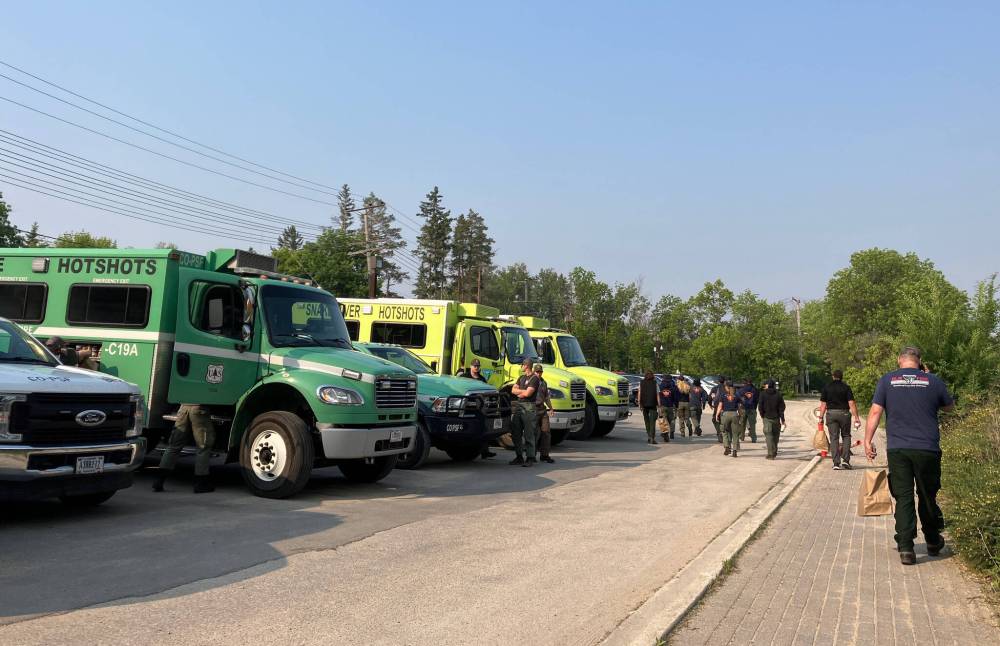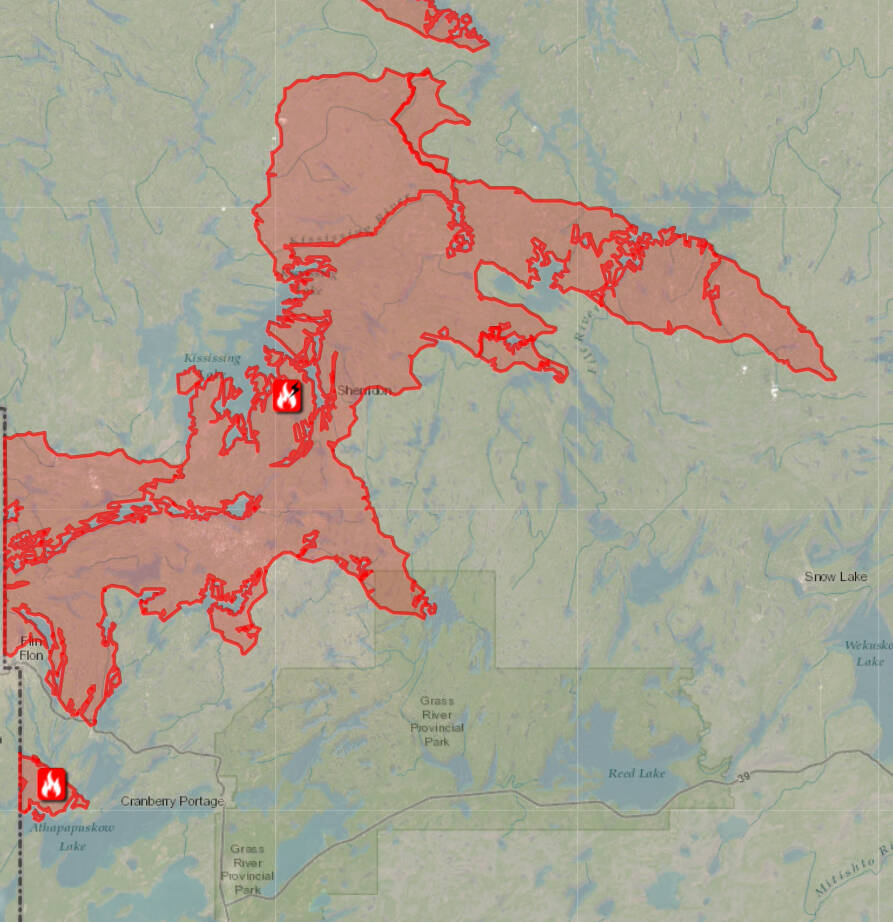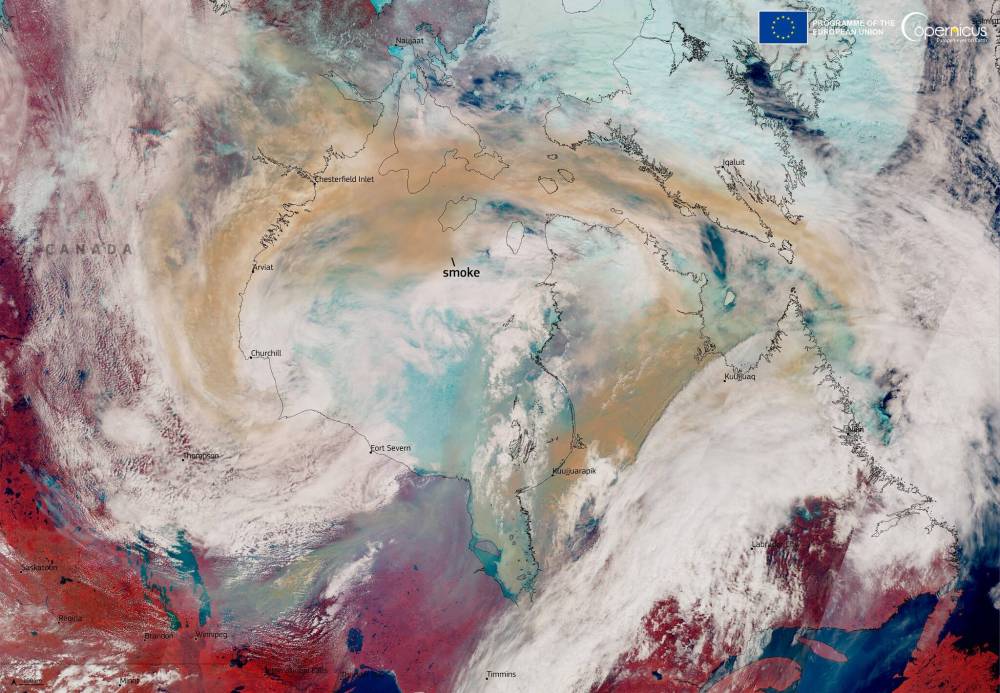‘It’s basically got a mind of its own’
More than 250 firefighters battle massive blaze on Flin Flon’s doorstep
Advertisement
Read this article for free:
or
Already have an account? Log in here »
To continue reading, please subscribe:
Monthly Digital Subscription
$0 for the first 4 weeks*
- Enjoy unlimited reading on winnipegfreepress.com
- Read the E-Edition, our digital replica newspaper
- Access News Break, our award-winning app
- Play interactive puzzles
*No charge for 4 weeks then price increases to the regular rate of $19.00 plus GST every four weeks. Offer available to new and qualified returning subscribers only. Cancel any time.
Monthly Digital Subscription
$4.75/week*
- Enjoy unlimited reading on winnipegfreepress.com
- Read the E-Edition, our digital replica newspaper
- Access News Break, our award-winning app
- Play interactive puzzles
*Billed as $19 plus GST every four weeks. Cancel any time.
To continue reading, please subscribe:
Add Free Press access to your Brandon Sun subscription for only an additional
$1 for the first 4 weeks*
*Your next subscription payment will increase by $1.00 and you will be charged $16.99 plus GST for four weeks. After four weeks, your payment will increase to $23.99 plus GST every four weeks.
Read unlimited articles for free today:
or
Already have an account? Log in here »
Manitoba bolstered the front lines against northern wildfires Thursday to help protect communities – including Flin Flon, where two blazes merged to become one behemoth — while the number of evacuees climbed to more than 18,000.
A team of 260 firefighters was trying to hold back flames on the edge of Flin Flon and neighbouring Creighton, Sask., as crews from Parks Canada and the U.S. headed north to battle out-of-control wildfires.
“They’re doing everything they can to protect the actual perimeter of the city,” Flin Flon Mayor George Fontaine told the Free Press. “(The fire) is massive. It’s basically got a mind of its own.”

PROVINCE OF MANITOBA
U.S. fire crews, in Manitoba to help with wildfires, prepare to leave the University of Manitoba in Winnipeg, Thursday morning.
The fire was more than 307,000 hectares on the Manitoba side of the provincial boundary — the largest in this province — after merging with a blaze near Sherridon.
No structures have been destroyed within Flin Flon’s limits, said Fontaine, an evacuee who is staying in Winnipeg after residents were forced to leave May 28.
An unknown number of buildings was destroyed outside of Flin Flon, said Kristin Hayward, assistant deputy minister for the Manitoba Wildfire Service.
She said officials were continually assessing risk and addressing areas of concern.
Fires ‘of note’ in Manitoba
Manitoba reported 27 active wildfires Thursday afternoon. These were among the fires “of note,” the province said.
Manitoba reported 27 active wildfires Thursday afternoon. These were among the fires “of note,” the province said.
EAST REGION
• Fire EA061 stretched from Bird River to Bissett, encompassing parts of Nopiming Provincial Park. It was 203,720 hectares.
• Fire EA063 originated in northwestern Ontario and spread to cover 5,000 hectares on the Manitoba side of the border, including parts of Whiteshell Provincial Park.
WEST REGION
• Fire WE017 merged with WE024 to become Manitoba’s largest wildfire, at 307,781 hectares. The merged blaze was on Flin Flon’s doorstep and also located near Sherridon.
• Fire WE021/26 near Easterville was 35 hectares and under control.
• Fire WE023 was about 4,900 hectares and out of control eight kilometres from Wanless and south of Cranberry Portage.
• Fire WE025 near Mathias Colomb Cree Nation (Pukatawagan) was out of control, covering about 9,800 hectares.
• Fire WE027 was about 2,500 hectares and out of control eight kilometres from Grand Rapids and Misipawistik Cree Nation.
• Fire WE028, also out of control, covered about 4,700 hectares 10 kilometres from Bakers Narrows Provincial Park.
NORTH REGION
• Fire NO002 close to Lynn lake was out of control and about 71,000 hectares.
• Fire No005 was five kilometres from Pimicikamak Cree Nation, the incorporated community of Cross Lake, Jenpeg Generating Station and Whiskey Jack Landing. The out-of-control blaze was about 3,300 hectares in size.
• Fire NO007, located two kilometres from Wabowden, was 88 hectares and under control.
• Fire NO010 near Tataskweyak Cree Nation (Split Lake) was out of control, covering about 21,000 hectares.
So far this year, the province has reported 111 wildfires, well above the average for June 5 (95 fires). About 90 per cent were caused by human activity, according to the Manitoba Wildfire Service.
“When you have a very large fire there are a lot of potential ways it could go, so we really want to dial that down and look at specific key areas of concern based on the forecast and conditions,” Hayward said at a news conference.
Reinforcements were on their way to a blaze that threatened Pimicikamak Cree Nation and the incorporated community of Cross Lake.
The fire has jumped from island to island. Pimicikamak Chief David Monias said one island stood between the blaze and the evacuated communities.
“We’re hoping that they can hold it and it doesn’t go across,” he said.
Monias said up to 35 structural firefighters, six pumpers, water bombers and a command team were on their way to join 30 local firefighters and a combined 70 wildland firefighters from the province and the U.S.
Earlier this week, Monias and other First Nations leaders asked the provincial and federal governments to send more help to front lines.
“We’ve got quite a few (personnel) coming. This is what we needed,” Monias said. “They’re doing the same (protection) they did for Flin Flon.”
A separate fire, nearly 71,000 hectares, remained an active and significant threat to Lynn Lake, the town said in a statement.

Manitoba Conservation
A provincial map shows the extent of the fire near Flin Flon (at lower left) on June 5, 2025.
In recent days, firefighters extinguished flames to prevent widespread damage and save Lynn Lake’s hospital in the evacuated town, the statement said. Some abandoned buildings were destroyed.
Hayward said cooler temperatures, higher humidity and low to moderate winds have helped crews make good progress on wildfires.
Officials expect those conditions to continue over the coming days. Predicted rainfall amounts this weekend are variable and uncertain.
“I’d like to remind Manitobans that just because you might see a blob of rain on that precipitation map, that’s not going to be enough to put out these fires,” Hayward said. “We will continue to be working on these fires for some time to come, but it certainly will help us to make good progress.”
Manitoba reported 27 active wildfires Thursday, with a seasonal total of 111. A dozen were out of control.
A provincewide state of emergency remained in effect.
Christine Stevens, assistant deputy minister for the Manitoba Emergency Management Organization, said 26 communities have evacuated and four are on short evacuation notice. Seniors or people with breathing or medical conditions voluntarily left some communities due to poor air quality from wildfire smoke.
More than 18,000 wildfire evacuees have registered with the Canadian Red Cross. Many evacuees have not registered because they are staying with family or friends, or they do not need supports, Stevens said.
A daily stipend for evacuees was set to begin Thursday.
Provincial policy aims to provide hotels rooms for all evacuees, said Lisa Naylor, the minister responsible for EMO.
She said 1,732 hotel rooms in Manitoba were assigned to evacuees, with 200 still available and another 200 set to become available.
Evacuees have so far occupied almost 800 hotel rooms in Ontario in places such as Niagara Falls. The province has faced questions over the decision to send people out of province.
Naylor said Manitoba secured 1,500 hotel rooms in Ontario for evacuees, and was happy to accept an offer for rooms in that province. The offer in Ontario was presented “before we were able to mobilize as many rooms here in Manitoba” at the start of the crisis, she said.

EUROPEAN UNION / COPERNICUS
A satellite image taken June 4 shows smoke from wildfires in the Prairie provinces billowing across the continent.
When the largest evacuation period began May 28, with Flin Flon (about 5,000 residents), Pimicikamak (about 7,500) and other communities, Naylor said about 2,500 people from elsewhere had already evacuated, and Manitoba was hosting evacuees from northwestern Ontario.
Using the Emergency Measures Act to free up hotel rooms in Winnipeg is an option if required, but the ideal method is acquiring rooms “in a voluntary way,” she said.
“We have been making incredible progress on that front.” Naylor said.
The province launched a new website, called Manitoba Ready, which displays information about wildfires, supports for evacuees and congregate shelters in Winnipeg and other cities.
Naylor said about 359 people were in shelters as of Thursday morning. The figure changes daily as people arrive or are moved to hotels.
Naylor said the province is working with Manitoba Keewatinowi Okimakanak to bring in First Nation safety officers to congregate shelters set up by the province and the Red Cross.
A shelter was set up at RRC Polytech’s Notre Dame Avenue campus Wednesday night, college spokesman Conor Lloyd said.
Natural Resources Minister Ian Bushie said Manitoba has deployed more than 650 people for firefighting efforts. More than 175 firefighters have joined from out of province.
“This is truly an all-hands-on-deck situation,” he said.
About 60 aircraft, including water bombers and helicopters with buckets, are involved.
About 100 firefighters and 25 managerial or support staff from the U.S. began making their way to front lines across Manitoba Thursday.
Some likely helped fight wildfires in the Los Angeles area in January, said Kristen Corkins, a U.S. National Interagency Fire Center international liaison officer who travelled to Winnipeg.
About 110 additional firefighters are expected to arrive early next week, she said.

The fire near Pimicikamak Cree Nation as seen in late May. (Submitted)
“Canada and the U.S. have had a really longstanding relationship,” said Corkins, referring to a formal arrangement struck more than 40 years ago.
Crews from Parks Canada and the U.S. were headed to the Rural Municipality of Kelsey, said Lori Forbes, the RM’s emergency co-ordinator.
Efforts were underway to protect structures in Cranberry Portage and Grass River Provincial Park. Cranberry Portage was evacuated for the second time in as many years due to wildfire.
“It’s wonderful, the more people that can help out,” Forbes said. “We all need respite. We’ve been doing this in the RM of Kelsey since May 3rd. People need to get some rest, and regroup and carry on.”
The crisis renewed the Canadian Association of Fire Chiefs’ calls for the federal government to set up a national administrative body to help co-ordinate the response of municipal structural firefighters in future emergencies.
“Canada is the only G7 country that doesn’t have one,” said president Ken McMullen, the chief of emergency services in Red Deer, Alta.
A national body exists for Canada’s wildland firefighters, he noted.
McMullen said situations where wildland and structural firefighters have to work together to battle blazes that threaten both forested and urban areas are becoming more common.
— With files from Maggie Macintosh
chris.kitching@freepress.mb.ca

Chris Kitching is a general assignment reporter at the Free Press. He began his newspaper career in 2001, with stops in Winnipeg, Toronto and London, England, along the way. After returning to Winnipeg, he joined the Free Press in 2021, and now covers a little bit of everything for the newspaper. Read more about Chris.
Every piece of reporting Chris produces is reviewed by an editing team before it is posted online or published in print — part of the Free Press‘s tradition, since 1872, of producing reliable independent journalism. Read more about Free Press’s history and mandate, and learn how our newsroom operates.
Our newsroom depends on a growing audience of readers to power our journalism. If you are not a paid reader, please consider becoming a subscriber.
Our newsroom depends on its audience of readers to power our journalism. Thank you for your support.
History
Updated on Thursday, June 5, 2025 1:40 PM CDT: Updates from news conference
Updated on Thursday, June 5, 2025 2:01 PM CDT: Adds comment from Naylor
Updated on Thursday, June 5, 2025 6:15 PM CDT: Adds factboxes, photos
















